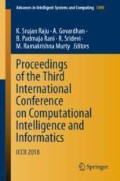Abstract
Cryptanalysis of cipher text-only attacks is by far the most challenging task in cryptology. This problem has been intimidating researchers as well, and till date no concrete approach has been suggested to address this problem. In this paper, we propose to identify the cryptographic algorithm by analysing the cipher text alone, using the clustering techniques. We have been successful in obtaining results which are able to indicate the cryptographic algorithm used. This methodology of using machine learning algorithms for cryptanalysis is a unique approach, and by looking at our results, it seems to be very promising as well.
Access this chapter
Tax calculation will be finalised at checkout
Purchases are for personal use only
References
Witten, Ian H., Eibe Frank, Mark A. Hall, and Christopher J. Pal. 2016. Data Mining: Practical machine learning tools and techniques, Morgan Kaufmann.
Stallings, William. 2006. Cryptography Theory and Network Security. Pearson Education.
Stinson, Douglas R. 2006. Cryptography Theory and Practice. Chapman Hall/CRC.
Heys, H.M., and S.E. Tavares. 1996. Substitution-Permutation Networks Resistant to Differential and Linear Cryptanalysis. Journal of Cryptology 9 (1): 1–19.
Biham, Eli, Adi Shamir. 1990. Differential Cryptanalysis of DES-like Cryptosystems, The Weizmann Institute of Science Department of Applied Mathematics.
Heys, Howard M. 2002. A tutorial on Linear and Differential Cryptanalysis. Journal Cryptologia 26 (3).
Rivest, Ronald L. 1991. Cryptography and Machine Learning. In International Conference on the Theory and Application of Cryptology, 427–439. Springer.
Lerman, Liran, Gianluca Bontempi, and Olivier Markowitch. 2011. Side Channel Attack: An Approach Based on Machine Learning. Center for Advanced Security Research Darmstadt, 29–41.
Barbosa, Flávio, Arthur Vidal, and Flávio Mello. 2016. Machine Learning for Cryptographic Algorithm Identification. Brazilian Journal of Information Security and Cryptography 3 (1): 3–8.
Madhuri, R., M. RamakrishnaMurty, J.V.R. Murthy, P.V.G.D. Prasad Reddy, et al. 2014. ClusterAnalysis on Different Data sets using K-modes and K-prototype algorithms. In International Conference and Published the Proceeding in, vol 249, 137–144. ISBN 978-3-319-03094-4.
Zabotin, I.A., G.P. Glazkov, and V.B. Isaeva. 1989. Cryptographic Protection for Information Processing Systems, Government Standard of the USSR, GOST 28147-89, Government Committee of the USSR for Standards.
Dolmatov, Vasily (ed.). 2010. RFC 5830: GOST 28147-89 encryption, decryption and MAC algorithms, IETF. ISSN: 2070-1721.
Leander, G., and A. Poschmann. 2007. On the Classification of 4-bit S-boxes, WAIFI, 159–176. SpringerVerlag.
National Bureau of Standards. 1977. Data Encryption Standard, G.S. Department of Commerce, FIPS pub. 46.
Jin, Xin, and Jiawei Han. 2016. Expectation Maximization Clustering, Encyclopedia of Machine Learning and Data Mining, 1–2.
Weka. 1999–2008. Waikato Environment for Knowledge Analysis Version 3.6.0. The University of Waikato, Hamilton New Zealand.
Author information
Authors and Affiliations
Corresponding author
Editor information
Editors and Affiliations
Rights and permissions
Copyright information
© 2020 Springer Nature Singapore Pte Ltd.
About this paper
Cite this paper
Tiwari, V., Pradeepthi, K.V., Saxena, A. (2020). Identification of Cryptographic Algorithms Using Clustering Techniques. In: Raju, K., Govardhan, A., Rani, B., Sridevi, R., Murty, M. (eds) Proceedings of the Third International Conference on Computational Intelligence and Informatics . Advances in Intelligent Systems and Computing, vol 1090. Springer, Singapore. https://doi.org/10.1007/978-981-15-1480-7_43
Download citation
DOI: https://doi.org/10.1007/978-981-15-1480-7_43
Published:
Publisher Name: Springer, Singapore
Print ISBN: 978-981-15-1479-1
Online ISBN: 978-981-15-1480-7
eBook Packages: Intelligent Technologies and RoboticsIntelligent Technologies and Robotics (R0)

